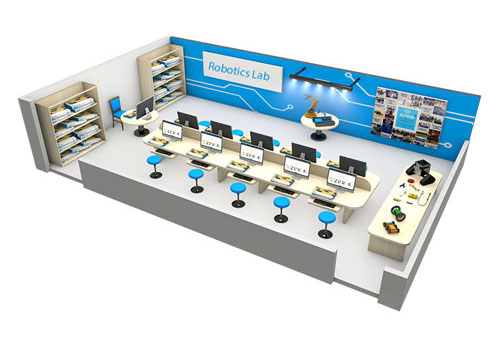Robotics Lab Setup for Schools & Classes – Empowering Future Innovators
Introduction to Robotics Lab Setup
In today's rapidly evolving world, robotics and automation play a crucial role in shaping the future. Setting up a Robotics Lab in schools and educational institutions equips students with practical knowledge, problem-solving skills, and hands-on experience in STEM (Science, Technology, Engineering, and Mathematics) education. A well-structured Robotics Lab fosters innovation, creativity, and technical expertise, preparing students for the careers of tomorrow.
A Robotics Lab Setup for schools and classes includes essential tools, software, and structured curriculum modules to introduce students to robotics, coding, artificial intelligence (AI), and automation. This setup ensures an interactive and engaging learning experience while developing critical thinking and teamwork skills.
Why Schools Need a Robotics Lab?
Hands-on Learning Experience – Encourages experiential learning through real-world robotics applications. Enhances STEM Education – Strengthens science, technology, engineering, and mathematics fundamentals. Encourages Problem-Solving & Creativity – Promotes critical thinking and innovation. Prepares for Future Careers – Develops skills required for careers in robotics, AI, engineering, and technology. Boosts Teamwork & Collaboration – Encourages students to work in teams on robotics projects. Bridges the Gap Between Theory & Practice – Helps students apply classroom knowledge in real-life scenarios.
Components of a Robotics Lab Setup
1. Robotics Kits & Hardware
• Beginner, Intermediate & Advanced Robotics Kits
• Microcontrollers (Arduino, Raspberry Pi, etc.)
• Sensors (IR, ultrasonic, motion, temperature, etc.)
• Motors & Actuators
• 3D Printing Modules
• AI & IoT Components
• Drone & Automation Tools
2. Coding & Programming Software
• Graphical Programming Interfaces (Scratch, Blockly)
• Text-Based Coding (Python, C++, Java, MATLAB)
• AI & Machine Learning Tools
• Simulation Software for Virtual Prototyping
3. Robotics Curriculum & Training
• Age-Specific Robotics Learning Modules
• Basic Electronics & Circuit Design
• Programming Concepts & Debugging Techniques
• AI, Machine Learning & Automation
• Real-World Robotics Applications
• Hands-on Project-Based Learning (PBL)
4. Lab Infrastructure & Setup Requirements
• Dedicated Robotics Lab Space
• Smart Boards & Interactive Panels
• High-Speed Internet Connectivity
• Power Supply & Safety Features
• Workstations & Storage Units
Benefits of a Robotics Lab in Schools
1. Early Exposure to Future Technologies
• Introduces students to robotics, automation, and AI at an early age.
• Builds confidence in handling technology and innovation
2. Encourages Experiential & Project-Based Learning
• Hands-on learning improves retention, understanding, and practical skills.
• Students engage in real-world problem-solving through robotics projects.
3. Fosters Creativity & Innovation
• Encourages students to design, build, and code their own robots.
• Promotes out-of-the-box thinking and technological curiosity.
4. Develops Coding & Computational Thinking Skills
• Introduces students to block-based and text-based programming.
• Enhances logical thinking and structured problem-solving.
5. Prepares Students for STEM Careers
• Equips students with skills required for careers in robotics, AI, IoT, and automation.
• Helps students participate in robotics competitions and hackathons.
Steps to Set Up a Robotics Lab in Schools
Step 1: Define Learning Goals & Curriculum
• Identify the age group and skill levels of students.
• Develop a structured robotics curriculum with progressive difficulty levels.
Step 2: Procure Robotics Kits & Equipment
• Choose versatile and expandable robotics kits.
• Ensure availability of sensors, microcontrollers, and actuators.
Step 3: Set Up the Lab Infrastructure
• Allocate dedicated space with proper workstations.
• Install smart panels, computers, and coding software.
Step 4: Train Educators & Instructors
• Conduct teacher training programs for effective robotics teaching.
• Provide guides and tutorials for curriculum execution.
Step 5: Implement Hands-on Learning & Robotics Projects
• Engage students in real-world robotics projects.
• Encourage participation in competitions and exhibitions.
Step 6: Continuous Upgradation & Assessment
• Regularly update the robotics curriculum with the latest advancements.
• Evaluate student progress with practical assessments and competitions.
Popular Robotics Lab Activities for Schools
1. Basic Robotics Projects
• Line Following Robot – Uses sensors to follow a path.
• Obstacle Avoidance Robot – Navigates around obstacles autonomously.
2. Coding & AI Integration
• Voice-Controlled Robot – Uses AI to respond to voice commands.
• Face Recognition System – Utilizes computer vision for detection.
3. IoT & Automation Projects
• Smart Home Automation – Controls appliances using sensors and programming.
• Weather Monitoring System – Uses IoT to track temperature, humidity, and rainfall.
Why Choose Our Robotics Lab Setup Services?
🔹 Tailored Robotics Lab Solutions – Designed for different age groups and educational levels.🔹 Latest Technology & Innovation – Updated with AI, IoT, and automation trends.🔹 Comprehensive Training & Support – Provides teacher training and student workshops.🔹 End-to-End Setup & Implementation – From procurement to curriculum design and training.🔹 Proven Success in STEM Education – Enhances student engagement and knowledge retention.
Frequently Asked Questions
1. What age group is a robotics lab suitable for?
A Robotics Lab is suitable for students from primary school (6 years old) to high school and beyond.
2. Do students need prior coding knowledge?
No! The curriculum is designed to teach coding from beginner to advanced levels.
3. Can teachers without technical backgrounds teach robotics?
Yes! We provide comprehensive teacher training and learning resources.
4. How long does it take to set up a robotics lab?
A standard setup takes 2-4 weeks, including installation, training, and curriculum integration.
5. What types of robots can students build?
Students can build autonomous vehicles, humanoid robots, AI-powered bots, and IoT-enabled automation systems.
6. How does a robotics lab benefit schools?
It enhances STEM learning, problem-solving, creativity, and innovation, making students future-ready.
Get Your Robotics Lab Setup Today!
Empower your students with cutting-edge robotics education and prepare them for the future of technology.
📞 Contact us today to get started with a customized Robotics Lab Setup for your school!

